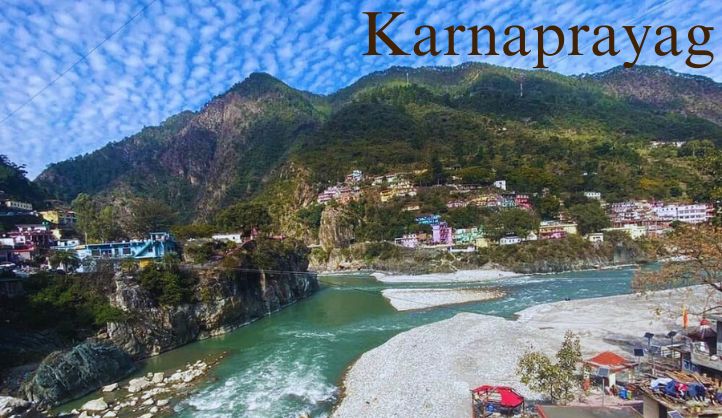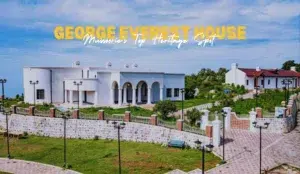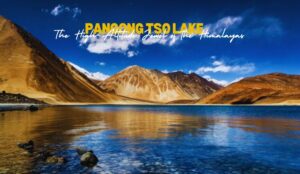In the picturesque Chamoli district of Uttarakhand, Karnaprayag is a quaint town that holds immense religious significance and offers breathtaking natural beauty. Situated at the confluence of the Alaknanda and Pindar rivers, Karnaprayag is one of the Panch Prayag (five confluences) of the Alaknanda River. This serene town is a perfect blend of mythological importance and scenic splendor, making it a must-visit destination for pilgrims, nature lovers, and adventure enthusiasts alike.
Mythological Significance
Karnaprayag derives its name from Karna, the legendary warrior from the Indian epic Mahabharata. According to the mythological tales, Karna, the son of the Sun God and Kunti, performed penance here to please his father and received the impregnable armor and earrings (Kavacha and Kundala) that made him invincible. The town is also believed to be the site where Karna meditated and worshipped the Sun God. The presence of the Karna Temple, dedicated to this heroic figure, stands as a testament to his devotion and adds to the spiritual aura of the place.
How to Reach
Karnaprayag is well-connected by road and can be easily accessed from major cities in Uttarakhand. The nearest airport is Jolly Grant Airport in Dehradun, approximately 200 kilometers away, while the nearest railway station is Rishikesh, about 170 kilometers away. Regular buses and taxis are available from these points to Karnaprayag.
Natural Beauty
Surrounded by lush green hills and snow-capped peaks, Karnaprayag offers stunning views of the Himalayan landscape. The confluence of the Alaknanda and Pindar rivers creates a mesmerizing sight, especially during the monsoon season when the rivers are in full spate. The tranquil environment, coupled with the soothing sound of flowing water, makes Karnaprayag a perfect spot for meditation and relaxation. The town is also a gateway to several trekking routes and offers opportunities for adventure activities like river rafting and camping.
Best Time to Visit
The best time to visit Karnaprayag is from April to June and September to November. During these months, the weather is pleasant, and the region’s natural beauty is at its peak. The monsoon season (July to August) should be avoided due to heavy rainfall and the possibility of landslides.
Nearby Places to Explore
Nauti Village
Rich cultural heritage, traditional Garhwali lifestyle, and beautiful views of the Himalayan ranges. It’s also the starting point for the Nanda Raj Jat Yatra, a significant pilgrimage and cultural event.
Adi Badri
Adi Badri is a group of ancient temples dating back to the Gupta period, dedicated to Lord Vishnu. The serene location and historical significance make it a must-visit.
Rudraprayag
The confluence of the Alaknanda and Mandakini rivers. It is a gateway to Kedarnath and Badrinath, two of the most important Hindu pilgrimage sites.
Gauchar
Gauchar is known for its large, flat grounds amidst the mountains, which host an annual trade fair. It’s a quaint town with beautiful views of the surrounding landscape.
Auli
A popular ski destination offering stunning views of Nanda Devi and other Himalayan peaks. In summer, it’s a perfect spot for trekking and enjoying the lush green meadows.
Chamoli
Chamoli is known for its scenic beauty and as a starting point for treks to the Valley of Flowers and Hemkund Sahib, a revered Sikh pilgrimage site.
Nandaprayag
The confluence of the Alaknanda and Nandakini rivers, offers tranquil surroundings and beautiful river views. It’s also a great place for meditation and relaxation.
Badrinath
One of the Char Dham pilgrimage sites, is dedicated to Lord Vishnu. The Badrinath Temple is a major spiritual destination, surrounded by stunning mountain scenery.
Kedarnath
Home to the famous Kedarnath Temple, one of the twelve Jyotirlingas dedicated to Lord Shiva. The trek to Kedarnath offers breathtaking views and a profound spiritual experience.
Conclusion
Karnaprayag, with its blend of mythological significance, natural beauty, and serene environment, offers a unique experience to visitors. Whether you are a pilgrim seeking spiritual solace, a nature lover looking to soak in scenic vistas, or an adventure enthusiast craving an adrenaline rush, Karnaprayag has something for everyone. A visit to this charming town will leave you with memories of a lifetime and a deeper connection to the rich cultural heritage of Uttarakhand.
FAQs about Karnaprayag
1. What is the significance of Karnaprayag?
Karnaprayag is one of the five sacred confluences of the Alaknanda River, known as Panch Prayag. It holds great religious significance as it is believed to be the place where Karna from the Mahabharata performed penance and received blessings from the Sun God.
2. How can I reach Karnaprayag?
Karnaprayag is well-connected by road. It is approximately 170 kilometers from Rishikesh and can be reached via NH 58. The nearest railway station is in Rishikesh, and the closest airport is Jolly Grant Airport in Dehradun, about 200 kilometers away.
3. What are the main attractions in Karnaprayag?
The main attractions include the Karna Temple, Uma Devi Temple, and Chandika Devi Temple. The confluence of the Alaknanda and Pindar rivers, the surrounding hills’ scenic beauty, and the nearby Nauti Village’s cultural heritage are also major draws.
4. What activities can I do in Karnaprayag?
Visitors can engage in various activities such as white-water rafting, kayaking, trekking, camping, and bird-watching. The serene environment also makes it an ideal place for meditation and yoga.
5. Are there any good accommodation options in Karnaprayag?
Yes, Karnaprayag offers a range of accommodation options, including budget guesthouses and mid-range hotels. These establishments provide comfortable stays with modern amenities while allowing guests to enjoy the area’s natural beauty.





